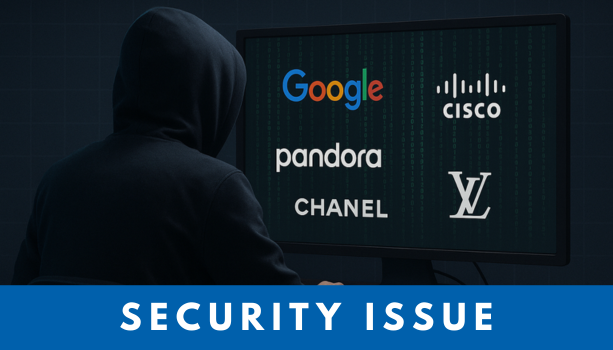[Security Issue] ShinyHunters CRM Cyber Attack
ShinyHunters CRM Cyberattack: A Wake-Up Call for Global Enterprises
The recent CRM cyberattack by ShinyHunters has shaken the global business world, affecting major corporations (Google, Cisco, Louis Vuitton, and Pandora). What’s more shocking is that the attack goes far beyond a simple technical hack. Instead, it targets the most fundamental vulnerability in corporate security: the human element.

How Did ShinyHunters Execute the Attack?
ShinyHunters CRM attack was done in a very simple steps: fooling the people.
Hacking Steps by ShinyHunters
ShinyHunters launched a highly targeted attack against companies using Salesforce’s CRM system. Importantly, the attackers did not exploit a zero-day vulnerability within the Salesforce platform. Instead, they used sophisticated social engineering techniques to deceive internal employees:
- Voice Phishing: First, the hackers impersonated IT support staff and called targeted employees directly.
- Deceptive Instructions: Then, the hackers instructed employees fake information such as “an urgent security update was required. Please enter an eight-digit code for verification.”.
- Malicious App Authorization: The code was actually a one-time authorization token for a malicious Connected App created by the attackers. When the employee entered the code on the Salesforce settings page, it granted OAuth-based access rights to the malicious app.
Once approved, this malicious app gained persistent, legitimate access to the company’s Salesforce data. As a result, hackers exfiltrated customer data, sales information, and sensitive corporate documents.
Severe Consequences and Key Implications
This cyberattack exposed critical weaknesses in corporate cybersecurity infrastructures:
- Bypassing Multi-Factor Authentication (MFA): MFA, considered a strong security layer, becomes ineffective when employees willingly authorize access to malicious apps. Rather than bypassing MFA, hackers tricked the final decision-maker—the human.
- Data and Intellectual Property Breach: The stolen data included customer PII, internal sales data, and valuable intellectual property. Then, ShinyHunters reportedly sold this data on the dark web or used it for extortion, demanding large sums in Bitcoin.
- Potential for Supply Chain Attacks: The attack demonstrated how targeting a widely used CRM platform can simultaneously compromise numerous organizations. It highlights a new form of supply chain attack that exploits trusted enterprise solutions.
Market Impact of the ShinyHunters CRM Attack
This incident is not limited to individual companies. It represents a growing threat to all organizations using cloud-based CRM solutions. Given Salesforce’s dominant position in the global B2B market, a single vulnerability in such a platform poses a risk to countless businesses.
Industry experts now predict that businesses will increase their focus on security audits when adopting cloud solutions. More specifically, traditional security measures like firewalls and antivirus software are no longer sufficient. Investments in advanced threat detection systems, such as User Behavior Analytics (UBA) and AI-powered monitoring, are expected to surge.
Moreover, this attack has made it clear that cybersecurity is no longer just a technical issue, and is a critical enterprise risk that C-level executives must take ownership of. In other words, companies must prioritize both the fortification of their systems and the enhancement of employee cybersecurity awareness.

How Should Companies Respond to Such Attacks?
ShinyHunters’ attack delivers a stark message: relying solely on technical defenses is no longer viable. A modern cybersecurity strategy must include robust systems and a security-conscious workforce.
- Regular and Practical Security Training: Conduct frequent simulations and awareness programs to educate employees about voice phishing, spear-phishing, and other social engineering attacks.
- Adopt a Zero Trust Architecture: Apply the principle of “never trust, always verify” for all users, devices, and networks. For sensitive platforms like CRM systems, enforce rigorous authentication for all API calls and app authorizations.
- Strengthen Identity and Access Management (IAM): Limit app authorization rights to a few trusted administrators. Minimize unnecessary API permissions and implement real-time monitoring to detect and block anomalous behavior immediately.
Even the most advanced technical defenses can be undermined if the human operators behind them are deceived. It is essential for companies to build holistic cybersecurity strategies that combine technology and human factors.
As a leader in global cybersecurity industry, Penta Security emphasizes proactive defense against emerging threats.
By offering solutions such as data encryption, web application firewalls, API security, and cloud protection, we enable enterprises to secure their most valuable assets. Our Zero Trust approach is realized through technologies like WAPPLES for access control, D.AMO for data protection, and Cloudbric for securing cloud environments.
With nearly three decades of experience, Penta Security continues to be a trusted partner for organizations seeking to safeguard their data assets in an increasingly complex threat landscape.
Click here to subscribe our Newsletter
Check out Penta Security’s product lines:
Web Application Firewall: WAPPLES
Database Encryption: D.AMO
Click here for inquiries regarding the partner system of Penta Security
Check out the product lines of Cloudbric by Penta Security:
Cloud-based Fully Managed WAAP: Cloudbric WAF+
Agent based Zero Trust Network Access Solution: Cloudbric PAS
Agentless Zero Trust Network Access Solution: Cloudbric RAS
Click here for inquiries regarding the partner system of Cloudbric
